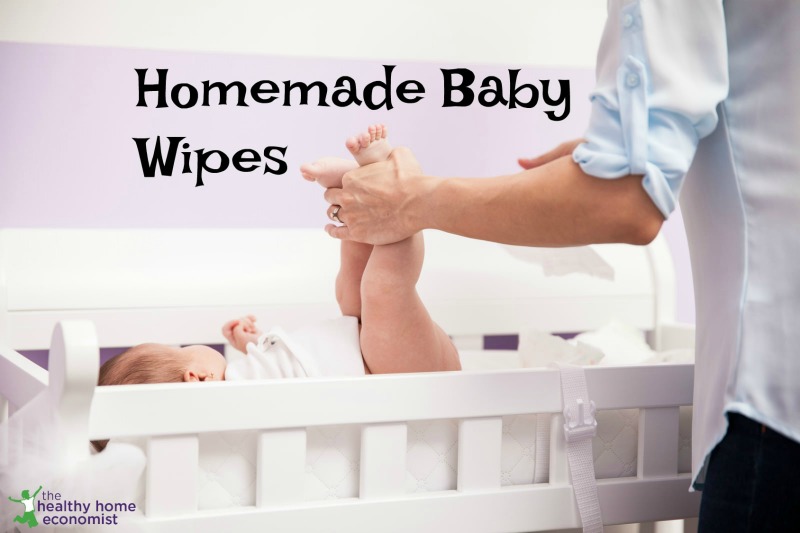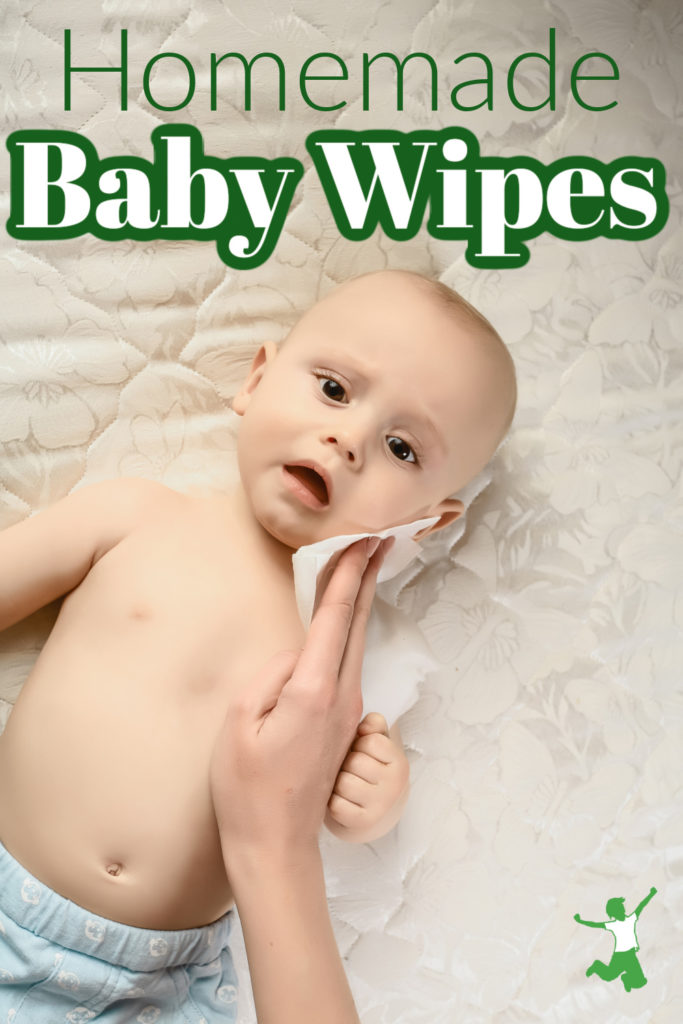Table of Contents[Hide][Show]
How to make organic baby wipes quickly and easily for less than a penny each. Made with non-toxic ingredients and reusable paper towels for convenient sustainability.

How to make organic baby wipes quickly and easily for less than a penny each. Made with non-toxic ingredients and reusable paper towels for convenient sustainability.
I remember so well holding my firstborn child for the very first time.
So precious. So vulnerable!
I couldn’t imagine any chemicals of any kind touching his delicate skin which is why I took what I thought were great pains to ensure any personal care products used were nontoxic.
I must have spend a fortune on hypoallergenic “natural care” baby wipes at that time for diaper changes (organic baby wipes were hard to find then), but looking back, those weren’t such a great choice after all.
Check out the list of unpronounceable, chemical-based ingredients of Huggies “Natural Care” Fragrance-Free baby wipes which is what I typically used:
- Purified water
- Phenoxyethanol
- Caprylyl Glycol
- Cocamidopropyl Betaine
- Malic acid
- Sodium Citrate
- Aloe Leaf Extract
- Tocopheryl Acetate
Can you pronounce all of those words? Unfortunately, as with food, personal care product labeling is typically misleading at best and purposely deceitful at worst.
Most concerning is new research from the Journal of Allergy and Clinical Immunology which suggests exposure to the chemicals in baby wipes are tied to the “perfect storm” for development of food allergies later by altering the composition of protective lipids on the skin. (1)
Environmental Working Group’s Skin Deep Database lists this brand of baby wipes as a high on the moderate hazard scale to your newborn’s health – not at all comforting to a new Mom!
Are There Nontoxic Brands?
Fortunately, there are brands of truly nontoxic options like Honest Wipes available, but they are very expensive, about 6-7 cents each even when on sale!
Honest Wipes are ranked a zero toxicity level by Skin Deep which is an excellent score. However, beyond being expensive, throw away wipes are really quite a wasteful and nonsustainable choice, especially for big diaper cleanup jobs when you might use 4-5 at a time.
By the time my third child came along, I had wised up and was making my own organic baby wipes. This way, you can be sure the wipes are convenient to use, completely nontoxic, nonwasteful, and budget-friendly.
When I was making organic wipes when my children were babies, I used durable brands of unbleached paper towels (don’t even attempt to use the cheap ones!).
Unfortunately, while inexpensive, traditional paper towels made with virgin wood pulp are still a wasteful choice considering the slow-growing trees used to make them.
Recycled paper towels might be considered a more sustainable, eco-friendly option, but studies have shown that recycled paper is contaminated with hormone-disrupting chemicals like BPA, BPS or both.
Bamboo a Sustainable Choice
So, what to use then other than cloth for making organic baby wipes which would be a bit pricey?
My suggestion would be to use bamboo paper towels (this is the brand I use). Bamboo is a fast-growing, sustainable, no-spray crop.
A roll of bamboo paper towels has the look and soft feel of regular paper towels. In addition, they are extremely durable and more absorbent than organic cotton rags and yet can be laundered numerous times!
This means if you make 80 organic baby wipes (4 wipes per towel and each roll costs around $4), plus about a dollar for the witch hazel mixture (buy in bulk or make it yourself), each wipe costs less than a cent each!
You can’t get any cheaper than that until your child is fully potty trained!
Here’s the how-to!

Reusable Organic Baby Wipes Recipe
Make your own organic baby wipes quickly and easily for less than a penny each. Made with nontoxic ingredients with reusable bamboo paper towels for safe, convenient sustainability.
Ingredients
- 1 roll bamboo paper towels
- 1 cup witch hazel
- 1 tsp aloe vera preferably organic
- few drops lavender essential oil optional
Instructions
-
Cut each bamboo paper towel into four squares. Mix the aloe vera and witch hazel together in a glass jar to make a gentle and soothing antiseptic.
-
Stack the wipes evenly one on top of the other in a large glass bowl and pour the witch hazel mixture evenly over them. Let stand until the liquid is fully absorbed.
-
Place the reusable baby wipes in a large ziplock bag for convenient use at home or when traveling.
-
Store used wipes in a separate double seal ziplock bag for easy laundering as needed.
Recipe Notes
Make three batches of these reusable organic baby wipes so that you have plenty of time to launder and re-wet with fresh witch hazel and aloe vera before you reach the end of the third bag.
These wipes are also fantastic to use to clean a yoga mat!
References
Recycled Paper Not Such a Great Idea After All
EWG Skin Deep Database









Thanks for this great idea, Sara ~
How wonderful to have this affordable and environmentally friendly option to the traditional, chemically laden baby wipes.
I will be sharing this awesome recipe on my social media platforms … thanks for continuing to provide incredibly helpful information!
Thanks Sarah! I just use nice paper towel and make up a homemade spray to wet them with each use, so no need ot make a big batch. My spray is just water, a bit of Dr. Bronner’s Baby Mild soap, and a few drops of melaleuca essential oil. Works great for us and is very inexpensive.
Has anyone tried the bleach pregnancy test? Do you think it’s a reliable one?
Wouldn’t you need some sort of (albeit natural) preservative to protect against microbes in the water? I’ve seen grapefruit extract used, for instance. Or does your natural antiseptic recipe serve as a preservative as well?
Do you have a source as to whether witch hazel, aloe and lavender oil are safe for baby’s underparts?
Thanks! Looking forward to this!
Witch hazel is antiseptic and there isn’t any water in this formulation.
Has anyone tried the BumBoosa brand of baby wipes? LuckyVitamin.com carries them. They appear to be quite free of chemicals.
I’d love to learn how to make my own witch hazel!! We use cloth wipes and I love them. I keep a spray bottle with witch hazel mixed with jojoba, lavender, and tea tree oils. I spray that onto baby’s bottom and then wipe away with the soft flannel wipes. It uses less of the liquid, I don’t have to keep wipes soaking, and it’s quite effective.
Hey Amanda,
I would LOVE to get your recipe on your baby wipe solution. Would you be so kind to share? Thank you in advance!
We currently use cloth wipes with water alone but I have a problem with mildew. Does the witch hazel/aloe combination prevent this? I’m hoping so because the reusable wipes work great with cloth diapers. I don’t have to worry about throwing the wipes in the trash and the cloth diapers in the pail–they all just go into one spot. Thanks!!
Thank you!!!! Excited to try this… Baby is due in 5 weeks 🙂
The bamboo towels ability to be washed and reused is great. Love the idea of cutting them into wipes size. I’m interested to see how they feel.
A little time cutting up some old clothes and sewing them into two-ply squares, run under warm water in the sink when needed, managed to get me through the ‘baby wipe years.’ I took them traveling, too – a wet bag easily held the cloth diaper and cloth wipes. I found plain water generally took care of cleanliness.
With elementary age children, we still use cloth in the bathroom for the whole family. A load of laundry here and there, it’s not complicated or expensive.
Love your articles! But the mathematics seems a bit off on this one?
You say that fabric wipes would a bit costly? 1 yard of wide width organic flannel will yield 55 wipes for about $18. Almost twice the price of the bamboo towels, but certainly not prohibitively expensive for DIY and still way cheaper in the long run than buying conventional wipes.
Looking at your recipe, the cost of 1 cup of organic Witch Hazel is close to $7.00! So one batch of 80 reusuable wipes including the cost of the solution, is over $7.00? Yikes! The Honest Brand Wipes you mention in the article are $4.95 for 72 wipes, which seems expensive enough, but yours are even more expensive than that? This doesn’t really seem to be a cheaper option at all?
What I’m factoring in is the reusability of the wipes which brings the price way down. Witch hazel is also very inexpensive if you make it yourself. I will be posting a recipe on how to do this soon 🙂 Also, the bamboo wipes are more absorbent than the cotton flannel. I think you would like them better.
Yes, the wipes are reusuable, but the solution isn’t. You still need to make a batch of solution each time, so the cost of that doesn’t go down and that is where the bulk of the cost is. : )
We use witch hazel a lot in our house, so I am looking forward to seeing your post on how to make it! Thanks!
Hannah, witch hazel is extremely inexpensive if you buy in bulk .. a cup is less than a dollar this way if you shop smart. Even less if you make it yourself.
I prefer organic cloth wipes and water myself, but I love witch hazel for my face. Looking forward to your recipe!